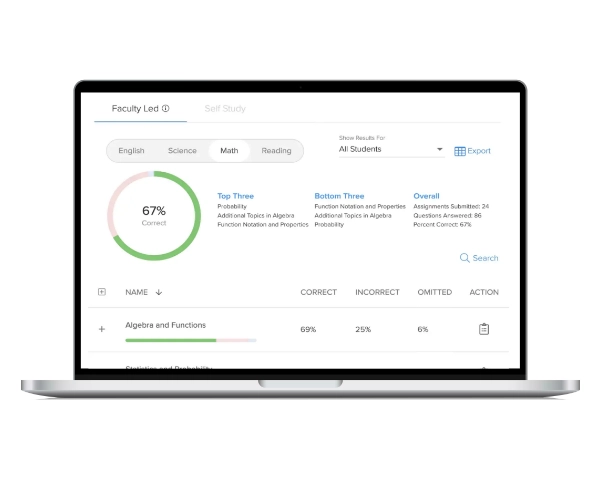Modern schools have not been around all that long in the context of human history. Throughout the 19th and early 20th centuries, most children earned their education in one-room schoolhouses. These consisted of a single space where children of all grade levels, typically first through eighth grade, were taught core subjects by a single instructor.
When modern-day students learn about the history of one-room schoolhouses, they frequently ask something akin to, “How did one teacher know how to teach each subject for every grade level?” In short, teachers had to understand how curriculum progresses throughout a student’s entire educational journey. They had to know that a child in grade one who was learning to read and write letters would eventually use that knowledge to read and write full-length poems and essays by grade eight.
This instructional skill set didn’t disappear when schools became the multi-room and multi-teacher institutions they are now. Educators must still understand how one grade level’s curriculum feeds into the next for their subject area(s) to prepare students for their entire K-12 academic journey. This understanding is what we know as vertical alignment, and it plays an essential role in all levels of coursework, including in AP® content areas.
What Is Content Area Curriculum Alignment?
Effective vertical curriculum alignment requires educators within a specific content area to work together to ensure students are well-prepared for the rigorous learning requirements of each grade level. This curriculum alignment group, called a vertical team, is typically led by an administrator and consists of teachers from multiple grade levels within a content area. Vertical teams discuss what students are expected to know when they begin a specific course and how what they learn throughout it will prepare them for the next one. For example, if a precalculus teacher understands what students need to know going into AP Calculus, they can prepare them accordingly and set them up for future success.
Why Vertical Alignment Teams are Important for AP Content Areas
Vertical teams promote curriculum alignment among various classes, including courses that lead up to and include AP courses. Discussing course requirements among Pre-AP and AP courses within a content area helps eliminate gaps in college readiness, especially within underrepresented groups of students in AP programs. Vertical alignment teams work to prepare all students for advanced coursework, closing academic gaps and promoting a foundation of critical thinking skills throughout a student’s academic career. This gives underrepresented students a far greater chance at succeeding in rigorous AP courses than through equitable access policies alone.
How to Create a Powerful AP Curriculum Alignment Team
There’s no one specific way to create a vertical team. Still, it is crucial to establish a consistent process and set of expectations to make it effective. Administrators or department chairs can also provide their teachers with a vertical team agenda and guiding questions to help facilitate meetings. A curriculum alignment process and meeting agenda might look like the following:
1. First, the content area team chooses an objective for vertical alignment discussion.
Guiding Questions:
- Is this concept objective scaffolded throughout several grade/course levels within the overarching content area?
- What should students already know about this topic when they begin each course? What should they know by the time they complete each course?
2. Each team member reflects on the content area objective before their next meeting.
Guiding Questions:
- What does this learning concept currently look like in my classroom?
- What is my course’s curriculum standard asking me to teach about this concept, and how should students demonstrate they’ve learned it?
- In past years, how have I taught this? (if applicable)
- What do I ask students to do while learning this concept in class?
- What resources, tools, and strategies work best to help students learn this?
3. The vertical team meets to discuss the content area objective.
Guiding Questions:
- What were our personal reflections about this concept before the meeting?
- What similarities/differences are there between grade level/course expectations for this learning concept?
- What similarities/differences exist between teacher presentation and learning standard expectations with this concept?
- How can we adjust our vertical alignment to serve our students better?
4. Teachers meet with their grade-level content area partners and make adjustments.
Guiding Question:
- Are there any adjustments we can make to our instructional approach with this learning concept so students will be more prepared for their next level of coursework?
What Can Administrators Do to Encourage Vertical Curriculum Alignment Teams Among AP Instructors?
In recent years, school districts have strived to find new ways to close learning gaps that have widened due to the COVID-19 pandemic. Although vertical teams are not a new concept, many schools are prioritizing their regular implementation for the first time. Administrators may require vertical alignment meetings on campus, but there are a few practical ways to encourage AP educators to “buy in” to their necessity. Here are a few simple steps administrators can take to do just that:
- Set aside time for AP teachers and instructors of related prerequisite courses to meet consistently. Many administrators incorporate content area curriculum alignment into their regular faculty meeting schedules.
- Help teachers establish “ground rules” for meetings, including timeliness, participation, and open sharing. Encourage each vertical team to create a group contract with agreed-upon expectations and norms.
- Maintain student data privacy requirements while sharing what’s working and what’s not for specific curriculum standards. Explore opportunities for prerequisite courses to support students before they begin an AP class, and discuss actionable steps teachers can take to address student misconceptions of complex concepts.
- Celebrate team accomplishments and encourage their dedication to work collaboratively toward curriculum alignment and student success.
Vertical vs. Horizontal Teams
Vertical teams are an excellent way for several grade levels to discuss the alignment of specific content area standards to close learning gaps and better prepare students for higher-level classes (such as AP courses). They are not, however, the only kind of content area team. Horizontal teams include educators who teach related content areas across the same grade or course level. For example, all AP science teachers might meet to discuss how various concepts carry over through their related courses and how to align their instruction better. AP Physics, AP Biology, AP Chemistry, and AP Environmental Science courses all include inquiry-based lab investigations–AP science teachers may choose to discuss the best way to ensure lab investigation alignment in all related subjects.
Horizontal teams can also meet across several subject areas within the same grade level. A professional learning community–or PLC meeting is an example of a horizontal team coming together to discuss student data and plan instruction. Whether meeting in a PLC capacity or getting together with your grade-level team to plan content, horizontal teams are just as important as vertical teams for curriculum alignment discussions.
Using Backward Design for AP Vertical Alignment
When working with a vertical team on a specific content area objective, it can be helpful to begin with the concept goal in mind. If a Pre-AP English teacher knows what a student needs to understand about an author’s point of view going into AP English Language and Composition, they can start with that end goal in mind and plan backward. This process ensures their students will learn what’s needed by the end of their Pre-AP English course. The idea of starting with the end goal in mind and then planning back from there is called backward design. Backward design is why vertical teams should discuss what their students need to know and how they must demonstrate their learning before they discuss instructional strategies. This approach is also an excellent way to plan during PLC and horizontal team meetings.
Key Takeaways
Education certainly has changed since the days of one-room schoolhouses. Still, one thing has not–a student’s journey from one grade level to the next is not an isolated experience dependent on one particular course. Rather, it’s the seamless continuation of a student’s academic career with every class they take, determining their college readiness.
Learn more about how UWorld helps educators prepare students for college readiness by providing exceptional AP-aligned content and insightful data with our Learning Tools for AP Courses.




